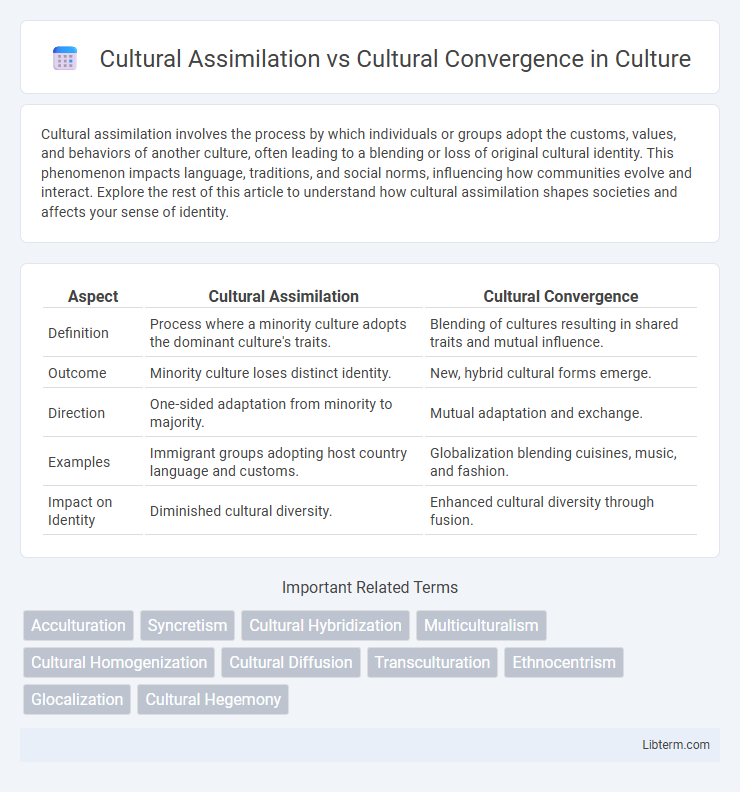Cultural assimilation involves the process by which individuals or groups adopt the customs, values, and behaviors of another culture, often leading to a blending or loss of original cultural identity. This phenomenon impacts language, traditions, and social norms, influencing how communities evolve and interact. Explore the rest of this article to understand how cultural assimilation shapes societies and affects your sense of identity.
Table of Comparison
| Aspect | Cultural Assimilation | Cultural Convergence |
|---|---|---|
| Definition | Process where a minority culture adopts the dominant culture's traits. | Blending of cultures resulting in shared traits and mutual influence. |
| Outcome | Minority culture loses distinct identity. | New, hybrid cultural forms emerge. |
| Direction | One-sided adaptation from minority to majority. | Mutual adaptation and exchange. |
| Examples | Immigrant groups adopting host country language and customs. | Globalization blending cuisines, music, and fashion. |
| Impact on Identity | Diminished cultural diversity. | Enhanced cultural diversity through fusion. |
Introduction to Cultural Assimilation and Cultural Convergence
Cultural assimilation occurs when individuals or groups adopt the cultural traits of another group, often losing their original cultural identity in the process. Cultural convergence describes the phenomenon where different cultures become more similar due to increased interaction, leading to shared values, technologies, and customs. Both concepts highlight the dynamic nature of cultural change influenced by globalization, migration, and communication advances.
Defining Cultural Assimilation
Cultural assimilation refers to the process by which individuals or groups adopt the cultural traits, customs, and behaviors of another dominant culture, often losing aspects of their original identity. This phenomenon typically involves the absorption and integration of minority cultures into a prevailing societal framework, leading to reduced cultural diversity. In contrast, cultural convergence emphasizes the blending and merging of different cultures, fostering shared values without complete absorption.
Understanding Cultural Convergence
Cultural convergence refers to the process where distinct cultures increasingly share similarities due to globalization, technology, and communication advancements, leading to a blending of customs, values, and practices. This phenomenon fosters mutual understanding and cooperation among societies, while preserving unique cultural identities through adaptive exchanges and hybridization. Key examples include the global spread of digital media platforms and international cuisine, which illustrate how diverse cultural elements merge without complete assimilation.
Historical Contexts: Examples of Assimilation and Convergence
Cultural assimilation is evident in historical contexts such as the Roman Empire's integration of conquered peoples, where local customs were replaced by Roman culture to establish political unity. In contrast, cultural convergence appears in the Silk Road era, where diverse cultures exchanged goods, ideas, and customs, leading to blended practices without complete cultural absorption. These examples highlight assimilation as a process of dominance and replacement, while convergence reflects mutual influence and coexistence.
Key Differences Between Assimilation and Convergence
Cultural assimilation involves one group adopting the customs and norms of another, often leading to the loss of the original cultural identity. Cultural convergence occurs when different cultures interact and share traits, creating similarities without erasing distinct identities. The key difference lies in assimilation's emphasis on one culture dominating or replacing another, whereas convergence promotes mutual influence and hybrid cultural growth.
Social Impacts of Cultural Assimilation
Cultural assimilation often results in the erosion of minority group identities, leading to loss of language, traditions, and social norms as individuals adopt the dominant culture. This process can cause social marginalization, reduced cultural diversity, and intergroup tensions due to perceived pressures to conform. The social impacts include weakened community cohesion within minority populations and challenges in maintaining cultural heritage across generations.
Effects of Cultural Convergence on Identity
Cultural convergence fosters the blending of diverse traditions, leading to hybrid identities that incorporate elements from multiple cultures. This process can diminish distinct cultural boundaries, encouraging shared values and practices while sometimes causing individuals to experience identity ambiguity. The resulting cultural synthesis often promotes greater social cohesion but may also challenge the preservation of unique cultural heritages.
Globalization: Catalyst for Assimilation or Convergence?
Globalization acts as a powerful catalyst for both cultural assimilation and cultural convergence by facilitating extensive cross-cultural interactions through trade, media, and migration. Cultural assimilation involves minority groups adopting dominant cultural traits, often leading to the erosion of distinct cultural identities, while cultural convergence signifies the blending and mutual exchange of cultural elements, fostering shared practices and values. The dynamic interplay of these processes under globalization shapes the evolving global cultural landscape, balancing homogenization and the preservation of cultural diversity.
Challenges and Criticisms of Both Processes
Cultural assimilation often faces criticism for eroding minority identities and promoting cultural homogenization, leading to loss of diversity and social marginalization. Cultural convergence struggles with challenges such as unequal power dynamics, where dominant cultures may overshadow or dilute less dominant ones, raising concerns about cultural appropriation. Both processes grapple with tensions between maintaining cultural uniqueness and adapting to global or dominant cultural norms, often sparking debates on identity preservation and cultural dominance.
Future Perspectives on Cultural Interaction
Future perspectives on cultural interaction emphasize the dynamic balance between cultural assimilation, where minority groups adopt dominant cultural traits, and cultural convergence, which encourages blending and coexistence of diverse cultures. Technological advancements and global connectivity accelerate cultural convergence, fostering hybrid identities while challenging homogeneous assimilation models. Emerging trends suggest increased recognition of cultural pluralism as a sustainable approach to managing global cultural interactions.
Cultural Assimilation Infographic

 libterm.com
libterm.com